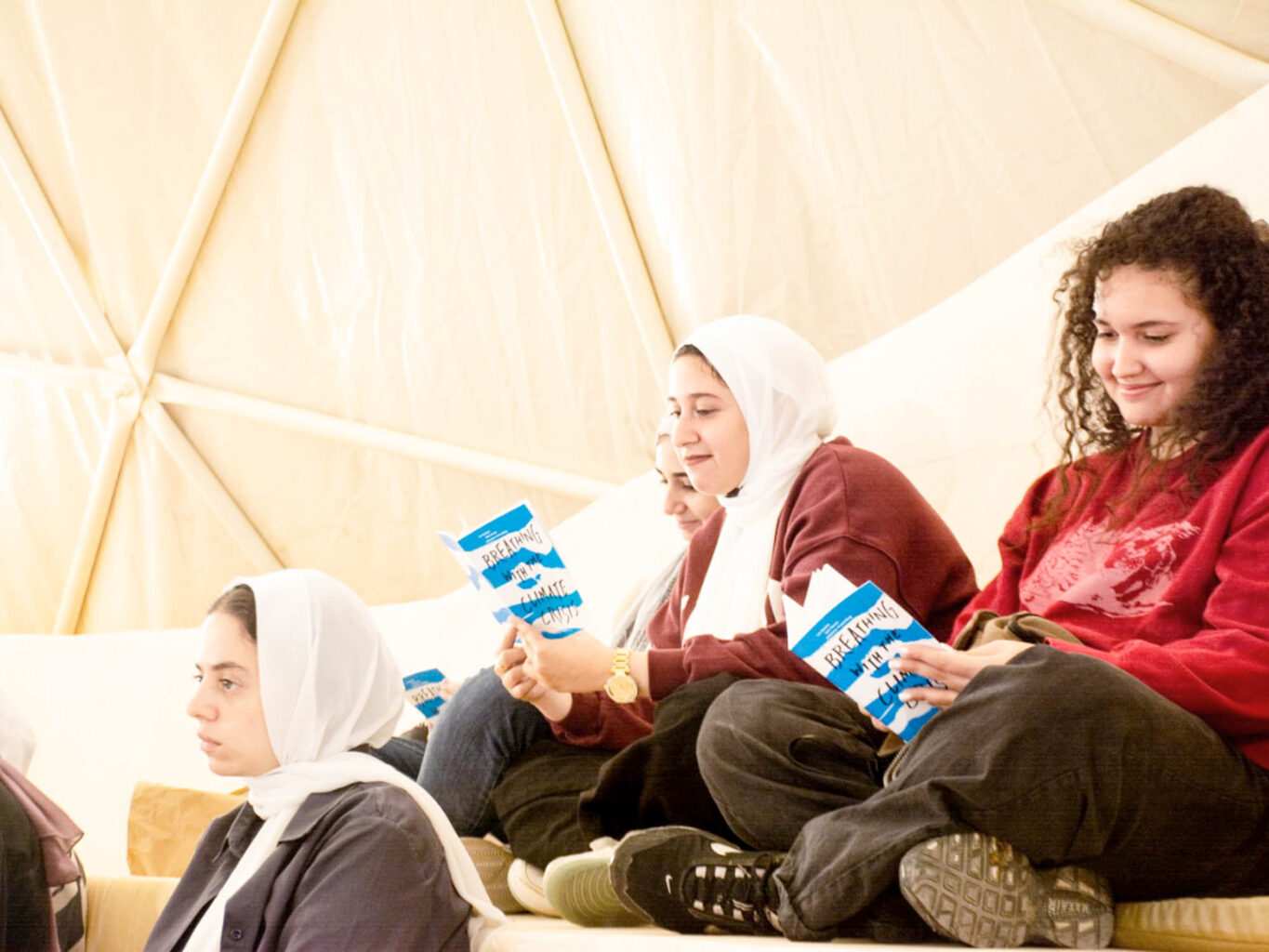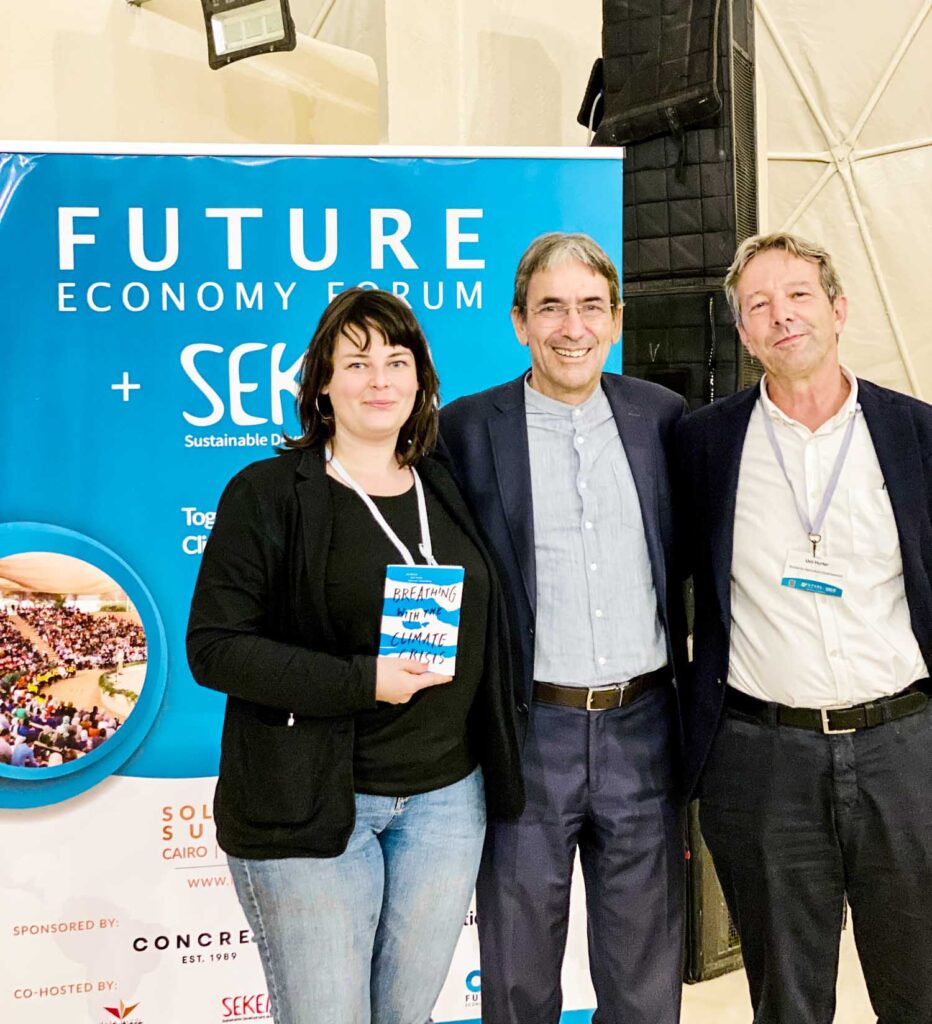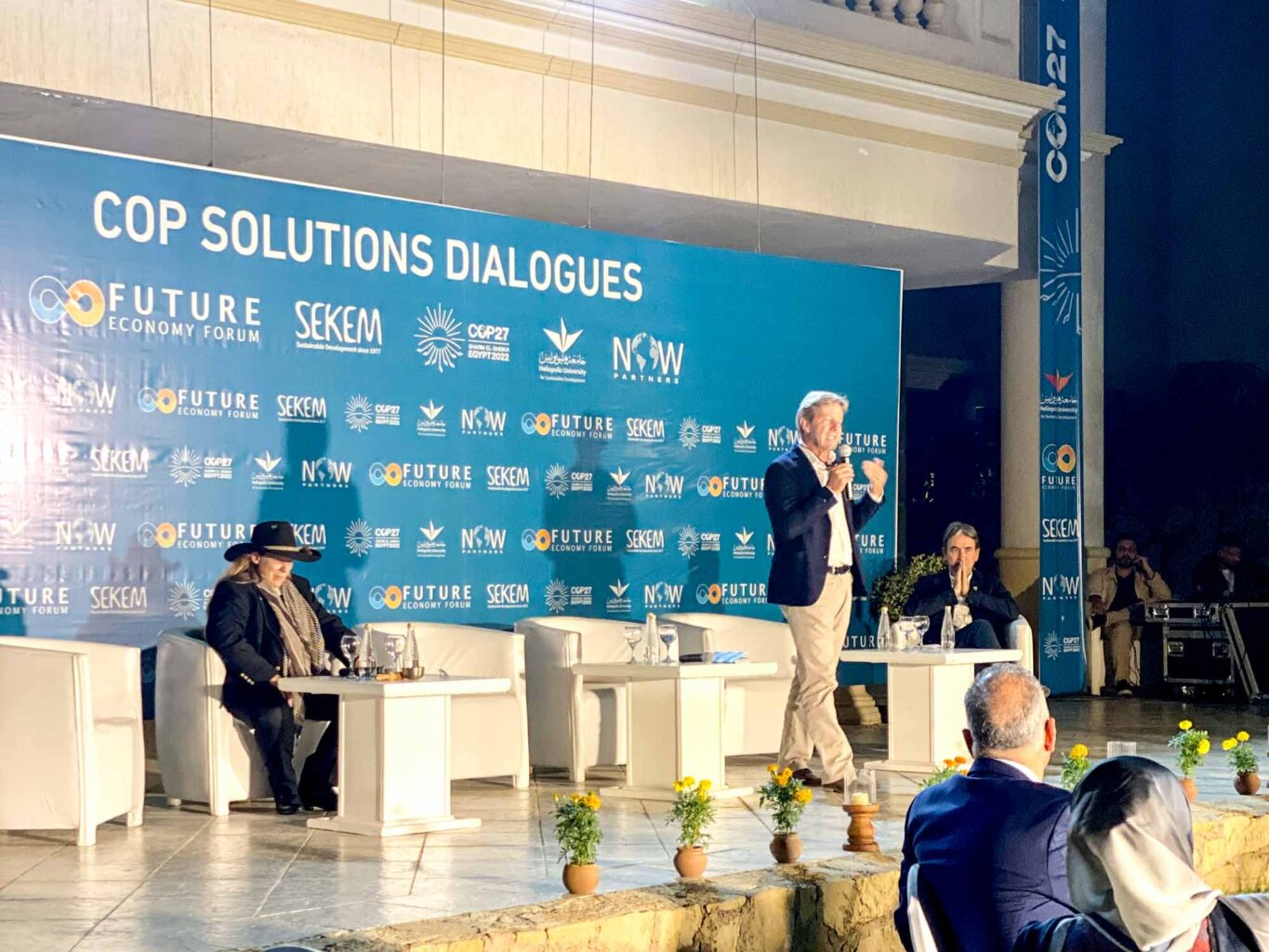The Goetheanum Agricultural Section’s Lin Bautze and Ueli Hurter participated in the COP27 Climate Conference in Sharm el-Sheikh, Egypt.
Back Story
In 2019, Guillermo Scallan asked Constanza Kaliks whether representatives of the Goetheanum or of the Anthroposophical Society wanted to visit the Climate Summit in Santiago de Chile, in order to bring Anthroposophical contributions to the challenges of the climate crisis. He would be organising round table discussions there on behalf of the Avina Foundation, and we would be warmly welcome. This call was surprising and challenging, for there was no basis – neither in knowledge nor in a field of activity – to be able to make a substantial contribution to the theme of the climate crisis out of Anthroposophy.
In the summer of 2019, all over the globe, Fridays for the Future were taking place, which were being initiated, above all, by young people. Accordingly, we took the decision to hold the Agriculture Conference in 2021 in tandem with the Youth Section on the theme of the climate. Experienced farmers, who have devoted their lives to working the earth, and young city-dwellers living as vegans and with deep convictions about treading on the earth properly, stood face-to-face, seeking perspective together. The conference itself had to be carried out 100% digitally, on account of Corona. It was a huge experiment, a complete novelty for the Goetheanum, and a success for many of the 1,200 participants from over 60 countries.
The Booklet «Breathing in the Climate Crisis»
Reviewing the conference, and in dealing with the theme of the climate crisis, we wondered whether or not we could and should make some of the results of the conference available to a wider public. For the most part, the climate discussion is carried out in a completely reductionist and mechanical way. Generally, it is a question of the sequestration of greenhouse gasses, with the aim of stopping global warming. Prognoses of an apocalyptic future arise through computer-simulations, which are followed by urgent imperatives to act – an urgency which does not allow other, more comprehensive and holistic viewpoints. However, at the conference, we definitely worked out viewpoints which moved beyond this strict, narrow approach. We experienced this together. Can we formulate these in such a way that they can lead to a contribution from Anthroposophy to the official climate negotiations?
The three of us – Lin Bautze, Ueli Hurter and Johannes Kronenberg – set about working, and at the end of August 2022, we finalised the manuscript of a little book, entitled «Breathing with the Climate Crisis». More stages of publishing followed, in particular, the graphic work by Mark Schalken and the translation into English, Spanish and French. On Friday, November 4th, 2022, Lin Bautze and Ueli Hurter travelled to Egypt – in joyful expectation of the 800 copies which our friends from Sekem printed for us, in order to distribute them at the COP 27 in Sharm el-Sheikh and at their pre-conference meeting at the Heliopolis University in Cairo.

«Breathing with the Climate Crisis» is written in language which is meant to speak to the heart. The argumentative style of language, which we are used to in contemporary academic and scientific culture, slipped away from us while we were writing. The dimensions of the living world, of the soul and spirit – genuine Anthroposophy – can come across as something contrived if they are offered to readers with un-asked-for explanations. We adopted a style of addressing the readers directly, especially for young people, and did not attempt to speak about the matter, but rather out of the matter. The content is now structured – after all the processes of condensing that the text went through – as four main statements:
- The earth is a living being and not a broken machine. Our body is part of the earth.
- We, as human beings, can get involved in a positive way. We are not condemned by our nature to destroy nature on the earth. On the contrary, the earth is waiting for our footprint. On account of our cultural abilities we are able to participate in shaping the earth’s future.
- This participation will become real if we are active and work the earth, if we farm in a healthy way, Biodynamically. As we all eat, we are all farmers. Biodynamic agriculture, as an example, benefits culture, builds up soil fertility and has a positive climate balance.
- There is no way to avoid being personally affected, nor around having knowledge and being personally involved. However, it does not need to get stuck at the personal level. Connecting with lots of people – potentially with everyone – is possible. Climate connects us all.
Before the COP 27 Conference, the Sekem Initiative and the Heliopolis University in Kairo launched the two-day «Solution Summit» with the aim of bringing in concrete proposals for solutions. The participants came from the areas of economics, politics and science. In addition, 300 students from the Heliopolis University came, as well as partners invited by the Sekem Initiative, to whom we belonged. Over the past months, the Sekem entrepreneurial group had itself worked out a solution, in the form of a proposal, and had developed it to be ready to be put into practice. The point is to turn agriculture from being a cause of the climate and environmental crisis into being part of the solution. To this end, in the current pilot phase, there are 2,100 small farmers who are converting to Biodynamic cultivation with composting, tree planting, building up the soil, and the installation of renewable forms of energy. These conversions will lead to a measurable binding of CO2, for which CO2 certificates can be awarded and for which there is a market. Through the sale of certificates, the farmers will generate additional income. This will enable them to sell Biodynamically produced food at the local market at the usual prices.

If we add up the results from 2,100 small farms that are now converting, it results in the following figures: 5,600 hectares of land, with 21,000 tons of bound carbon, 636,363 trees, and 70,000 tons of compost. That results in 84,000 certificates, for a total amount of 2.1 million Euros. Of course, this only functions if there are buyers for these certificates. Furthermore, money is required for helping with the conversions and the schooling of the farmers. At COP 27 in Egypt, the next phase of the project is now starting, which is to involve 40,000 farmers. In the environment of this contribution and other practical solutions, in which the monetary aspect plays an important role, our little book with its completely different approach was distributed to all the 400 participants. It was well received; the students were really glad and proud to hold it in their hands. They will work on the content together with their professors. And we had the impression that for many participants, it was a good complement to the numerical CO2 acrobatics.
The COP 27 in Sharm el-Sheikh
The journey then carried on to the southern tip of the Sinai peninsula, where in the last 40 years a small fishing village has turned into «Sharm el-Sheikh», the all-round tourist and conference destination. The airport dates back to the Israeli occupation after the Six-Days War. This November, 40,000 people travelled there from all around the world to discuss the earth’s climate together. The COP (Conference of the Parties) is a UNO conference that has been taking place each year since 1995. The bases for the negotiations are the scientific reports on climate change and relevant scenarios of the IPCC (Intergovernmental Panel on Climate Change). At the COP 21 in Paris in 2015, governments agreed bindingly to a 1.5 C goal.
Each state determines its own climate policy in order to achieve the common goal, yet it regularly gives an account of its actions. The noble goals are one thing, the interests of the individual states and their economies is another. In the negotiations there is some hard haggling, for instance, about withdrawal scenarios from the coal industry or transfer payments from the North to the South, etc. Negotiations are carried out by the states, though selected representatives from the economic life and civil society are authorised to attend; and thus the COPs are becoming huge events with a complex structure.
Our base was a stall of Heliopolis University, where the project with the CO2 certificates, described above, was presented and our little book was displayed. The little book, with its light-blue/white cover, was an eye-catcher, and we were actively giving copies away, above all, to the many young visitors. During the COP, lots of events take place on different stages, on an hourly basis. The usual format is a panel, in which three to six people handle a theme with brief contributions. The format requires each participant to blurt out something quickly, which a lot of people are well able to do. At each panel you could learn a lot in a very concentrated form. This year, a lot of NGOs were not accepted to be part of the panels; neither were we. The representatives of Sekem, though, were on the stage again and again and were able to present their approach. Helmy Abouleish, especially, was a sought after man. He knows a lot of ministers and entrepreneurs from Egypt and has good networks internationally, when it comes to the themes sustainability, agriculture and new forms of economic working. After a few days you end up with a whole pile of business cards from great people, who informed you of their impressive projects. In this manner the huge conference community enters the realm of real experience. Biodynamics and even Demeter were reasonably well known, especially because at every opportunity the Sekem co-workers emphasised their Biodynamic approach. Anthroposophy, the Goetheanum and the Agriculture Section, on the other hand, were known to only a few people. For this reason our little book was a welcome bridge-builder.

The Villa by the Sea
For the two weeks of COP, Sekem ran a hotel, so to speak: a villa directly on the Red Sea was rented. Around 40 beds were available and during the entire period roughly 100 people could be accommodated. The garden is the only green spot that can be found in Sharm el-Sheikh with Google Earth; it was turned into an open-air restaurant with 150 seats and Biodynamic cuisine thanks to the products from Sekem. Thus breakfast and the evening meal in the green garden by the sea were particularly valuable times to converse with the many interesting participants from all over the world. Every evening, according to the COP theme of the day, there was an event with a panel format with the title «COP Solutions Dialogues». A few months beforehand the «Future Economy Forum» had been brought into being; the organisers had set themselves the benchmark of getting a conversation under way on concrete solutions for a new economic system. Starting from the fact that ecology and sustainability appear as costs in business accounting and the wider economic system and, therefore, to this day – 50 years after the report «The Limits to Growth» of the Club of Rome – are treated not as economic factors but as philanthropic, the challenge for the speakers was to demonstrate their concrete proposals towards solutions for the coming 12 months. «Regenerative economics» should become mainstream, that was the maxim. There were some really courageous appearances, in particular from Sandrine Dixson-Decleve, Co-President of the Club of Rome, and many others. In this framework, it was anything but easy to make a statement on behalf of the Biodynamic movement. Our view of ourselves is that we have been carrying out for a hundred years a lot of what is just now the fashion. This faces us with the critical challenge of being able to formulate our century of experience in a highly relevant and topical way. And the burning question is: what are the completely concrete contributions that we want to introduce in the near future? People who know the Goetheanum, such as Patrick Holden, for example, who has set himself the task of lobbying for sustainable agriculture and food production in conventional economic circles, were very much aware of our presence and appreciated it.

Conclusion
After a week, we departed. The negotiations were not over. From those who stayed on we
have heard that any progress has been moving with great difficulty. After a week of great effort from seven in the morning until late evening, no ground had been gained for taking agricultural systems into account that are kind to the environment. The agrobusiness lobby successfully blocks everything. On the other hand, in the circles in which we have been moving and to which we belong, the knowledge that Biodynamic Agriculture and many related forms of ecological cultivation can make an effective, positive contribution to the climate has consolidated. Thereby, the currently accepted estimate that approx. 30% of the climate gas emissions come from agriculture and food production is designated as the ecological footprint of conventional agriculture. Conversion to ecological agriculture is able not only to prevent this negative footprint from happening, but also to overturn it. A good portion of the emissions from the resource-consuming economy can potentially be recovered through agriculture and absorbed by the life processes of the soil, the plants and trees. During the days at the COP 27, the will grew to strengthen this approach in a focused way, so that it can be brought in at the next COP (28) in a dynamic way. At the Agriculture Section and the Goetheanum, we want to pursue this theme further. As a next step we shall try to spread the call in «Breathing with the Climate Crisis» far and wide.














Thank you for such a heartening article. It is so important to engage with these international conferences in a way that speaks to the heart.